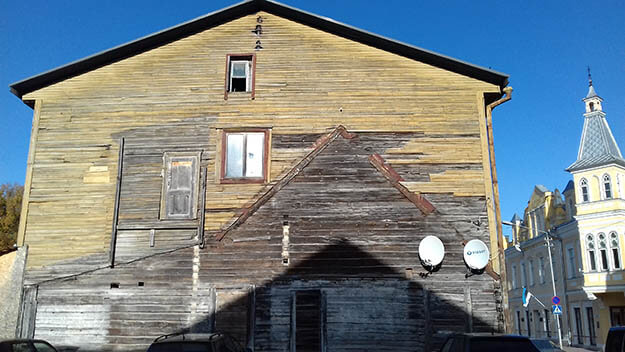
Not a kummitus/maja (haunted house), but a ghost building, aka architectural palimpsest or even “architectural fossil art”. The vaim (ghost) of the former building that used to be cozied up against its naaber (neighbor), can still be seen on Pikk tänav, Rakvere’s main drag. Don’t be scared, step up close and ponder what once was. Photo: Riina Kindlam
They can be seen the world over. A reminder that urban environments are constantly in flux, with arendus (development) and regeneration seemingly unstoppable. When row homes or old buildings from past sajandid (centuries) are torn down, they often leave a striking remnant on the walls they used to share with their surviving naaber. These ghostly outlines and relics of vanished buildings sometimes feature missing staircases or faded tapeet (wallpaper). Others are merely the piir/jooned (outlines) of the house itself: pitched roof and old korsten (chimney stacks), resembling an abstract architectural drawing. They endure in much the same way as “ghost signs”, the faded, painted old advertisements that can sometimes be found clinging to old brick walls.
I was recently overjoyed upon learning that this fenomen has a name – thanks to @urbanarchiveny (Urban Archive New York) on Instagram, dedicated to uncovering the history of New York City. On 15. oktoober they posted a old photograph from Brooklyn featuring an example of an architectural palimpsest or ghost building and the explaination: “A palimpsest is traditionally a parchment made from animal hide that has been scraped “clean” again, so that new text can be written on it. In many cases, the ghost of the original text can be seen faintly behind the new words. In the case of architecture, a palimpsest is the partial remains or outline of a vanished building seen on existing buildings.” The rather challenging word is the same in Estonian: “palimpsest – pärgament, millelt varasem kirjutus on ähmastatud või kustutatud ja uus peale kirjutatud”.
In the spirit of Hallowe’en, as well as Estonian hingede/aeg (time of spirits in November), there’s something thought-provoking and a bit haunting about detecting the trace of a staircase, or an uks (door), and starting to imagine the lives lived in what is now emptiness. A ghost is a kummitus and if a place is haunted then seal kummitab.
Us ghostbusters gotta stick together… the Instagram account @ghostbuildings spotted my thematic hashtags along with this example from Rakvere and asked if they could re-post. By all means! I was honored to have these Viru vaimud ja varjud (spirits and shadows from Virumaa) featured. If nostalgia and curiosities are your thing, check out messynessychic.com based in Paris, which includes the article “The Haunting Magic of Ghost Buildings”.
Riina Kindlam,
Tallinn













